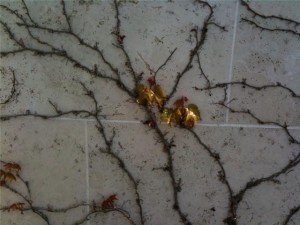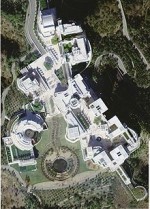 A March visit to the Getty Center Garden introduced us to a very different look we had from past visits in the summer, fall and winter. Just as the art exhibits at the Center change so do the gardens as new plant material leafs out, blooms, and fades. The visits are never the same and this visit allowed us to see the azaleas in the pool garden off the Center Garden in bloom, something we had never seen before. Our focus for this visit was the Center Garden but we also visited other garden areas, each with its own unique characteristics.
A March visit to the Getty Center Garden introduced us to a very different look we had from past visits in the summer, fall and winter. Just as the art exhibits at the Center change so do the gardens as new plant material leafs out, blooms, and fades. The visits are never the same and this visit allowed us to see the azaleas in the pool garden off the Center Garden in bloom, something we had never seen before. Our focus for this visit was the Center Garden but we also visited other garden areas, each with its own unique characteristics.
 The architect of the Getty Center, Richard Meier, is known for his striking white buildings that reflect his notion of architecture as sculpture. In his own words, he sought to “pursue the plastic limits of modern architecture to include a notion of beauty molded by light.” The site, overlooking mountains, ocean, and the urban mass that is Los Angeles, inspired Meier to integrate nature and culture and many areas of the site include plantings that soften the overall appearance.
The architect of the Getty Center, Richard Meier, is known for his striking white buildings that reflect his notion of architecture as sculpture. In his own words, he sought to “pursue the plastic limits of modern architecture to include a notion of beauty molded by light.” The site, overlooking mountains, ocean, and the urban mass that is Los Angeles, inspired Meier to integrate nature and culture and many areas of the site include plantings that soften the overall appearance.
The large staircase, called the Spanish Steps by our guide, greet the visitors as they exit the tram from the parking lot below. Although on a smaller scale than those in Rome their brightness leads the visitor to squint or don sunglasses.
Large pots adorn the steps, with sweet alyssum blooming now but more to come in the future weeks and months.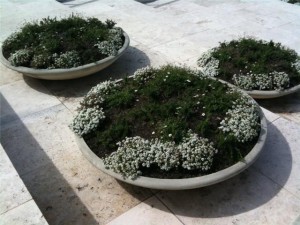
To the side, a water staircase adds sound, sparkle, and movement to the stairs, reminding me of those at the Generalife in Granada, Spain, or Villa Lante in Bagnaia, Italy, but in a modern idiom.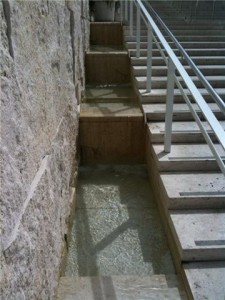
Along one wall rosemary drapes over a wall accented by fountains, reminiscent of the fountain wall at Villa D’Este, in Tivoli, Italy.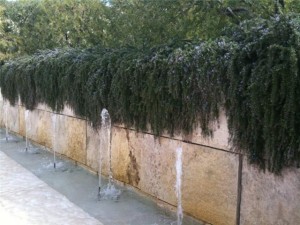
A pergola with vines growing up the sides to provide shade is a pleasant place to rest or savor the view.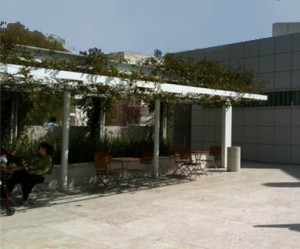
Several times a year the sycamores are pruned to create a sculptured look and allow the visitor to enjoy the spotted bark that echo the spottedness of the travertine stone that is used as facing on the nearby buildings. In summer the trees will be covered with large leaves to provide shade. In the distance, a pale lavender pergola is entwined with wisteria that will bloom with lavender flowers, the only color Meier allowed.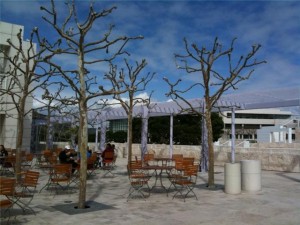
The Italian pines planted in large sunken pots recall the Mediterranean climate of the site.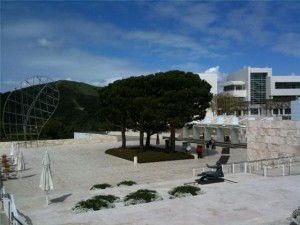
A planting of birds of paradise create the foreground for majestic view towards the mountains.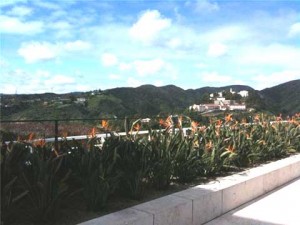
A water channel hints at the garden below.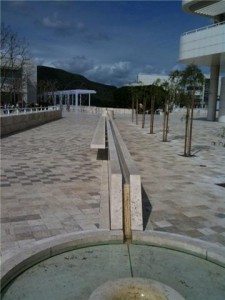
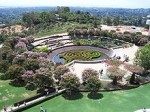 Once the building design of the Center was determined, the Getty Trust hired Robert Irwin to design the main garden area. A painter and sculpture, Irwin knew nothing about plants and saw the garden as a way to express his aesthetic in a new and different way. He was quoted as saying that the Central Garden at the Getty “is a sculpture in the form of a garden, which aims to be art.” The garden he designed provides a contrast to the architecture of Meier and encourages the visitor to enjoy the garden experience from grand vistas toward the ocean and mountains to individual plants with varying levels of involvement. As the visitors descend from the high ridge where the buildings are located, to the pool in the lowest part of the garden they enjoy a variety of sights, sounds, and scents. The plant material was chosen on the basis of artistic considerations including texture, form, and color as well as how these characteristics would effect their interaction with light and reflection.
Once the building design of the Center was determined, the Getty Trust hired Robert Irwin to design the main garden area. A painter and sculpture, Irwin knew nothing about plants and saw the garden as a way to express his aesthetic in a new and different way. He was quoted as saying that the Central Garden at the Getty “is a sculpture in the form of a garden, which aims to be art.” The garden he designed provides a contrast to the architecture of Meier and encourages the visitor to enjoy the garden experience from grand vistas toward the ocean and mountains to individual plants with varying levels of involvement. As the visitors descend from the high ridge where the buildings are located, to the pool in the lowest part of the garden they enjoy a variety of sights, sounds, and scents. The plant material was chosen on the basis of artistic considerations including texture, form, and color as well as how these characteristics would effect their interaction with light and reflection.
The water channel in the upper level sends its contents into a huge vase shaped fountain below where the stream that flows through the garden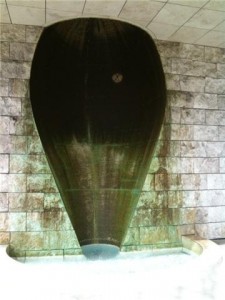
The top of the stream is marked by large boulders set so that the visitor can not see the water but can hear it.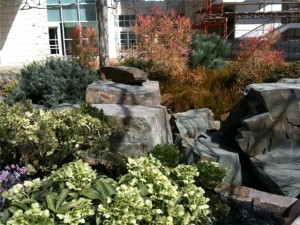
As the stream descends, the boulders are more widely spaced and the sight of the water becomes more important.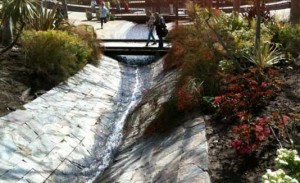
In the lower part of the stream the rocks are gone and the stream bed is formed by stones set on edge.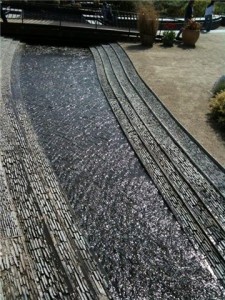
All along the path of the stream London plane trees ‘Yarwood’ were planted providing shade in the summer but trimmed so that they are open enough to permit a large variety of plants to grow beneath them in all times of the year.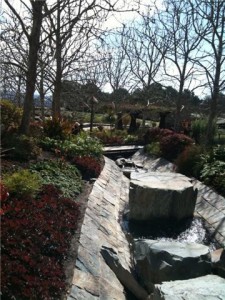
Deer grass, a California native, is extensively planted along the stream because of its year round interest.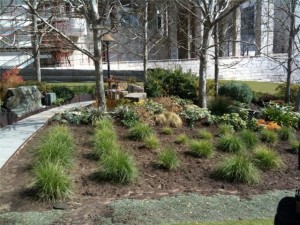
The path down into the garden is a switch back with sharp turns.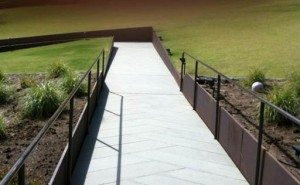
A bench along the path provides a change to sit and experience the sounds as well as the sights.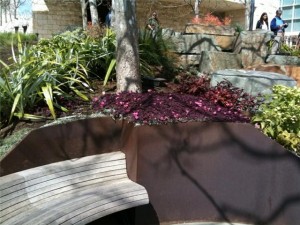
Irwin divided the beds along the stream into four areas and planted them according to their leaf color and texture. At the top Eceverias are tightly massed in front of lavender that gives them scale.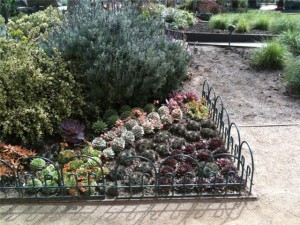
A bed at the bottom of the stream is bright with color.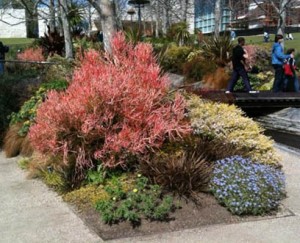
The plantings along the stream garden end with a large open plaza where two groups of three huge umbrella-shaped trellises stand covered with bougainvilleas.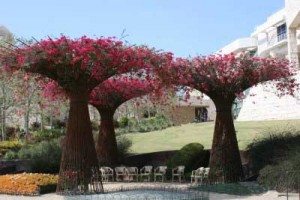
A circular pool lies below with its maze consisting of three interlocking circles of azaleas in three different colors. The azaleas look as though they are floating but are actually planted in waterproofed containers. And yes, deer are a problem with a herd of 40 of them coming to feast when the azaleas are in bloom.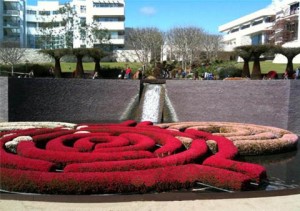
The large circular garden around the pool is divided into four areas where flower color becomes more important.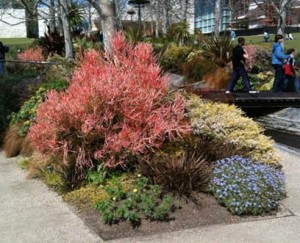
The far side of the Bowl Garden is devoid of plants with a simple, uninteresting sort of look; the perfect look to force the visitor to forgo the view toward the sea and instead look at the spectacular garden Irwin has created for the architecture above.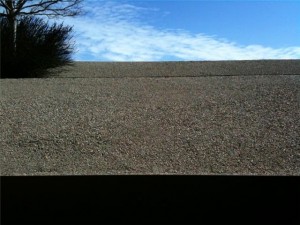
In this area Irwin left a heart with the names of his wife and daughter.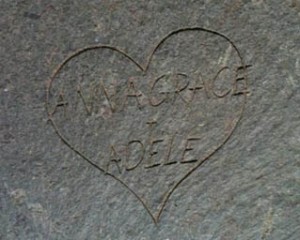
Irwin saw that the garden was a work in progress and he said “Always changing, never twice the same”; these words are the perfect invitation to return to the garden frequently and enjoy the new experiences it has to offer.
